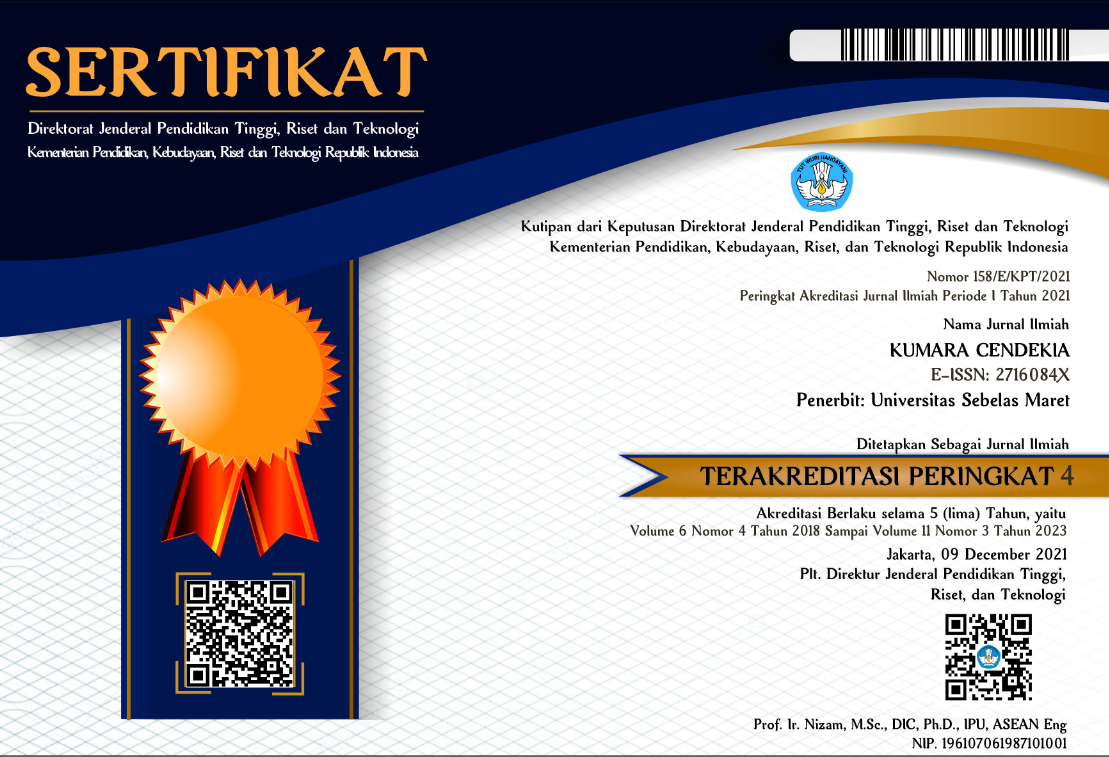PENERAPAN PERMAINAN LARI ESTAFET MODIFIKASI UNTUK MENINGKATKAN KOMPETENSI MOTORIK ANAK USIA 5-6 TAHUN
Abstract
ABSTRAK
Kompetensi motorik merupakan aspek penting yang harus dikembangkan pada anak usia dini sebagai persiapan pada kompetensi selanjutnya. Kompetensi motorik dapat dikembangkan melalui permainan lari estafet modifikasi. Penelitian ini bertujuan untuk meningkatkan kompetensi motorik anak usia 5-6 tahun melalui penerapan permainan lari estafet modifikasi. Penelitian ini merupakan penelitian tindakan kelas dengan pendekatan kuantitatif dan kualitatif. Sumber data dalam penelitian ini adalah anak dan guru. Teknik pengumpulan data dilakukan melalui unjuk kerja, observasi, wawancara dan dokumentasi. Teknik uji validitas data menggunakan triangulasi sumber dan triangulasi teknik. Hasil penelitian menunjukkan bahwa melalui penerapan permainan lari estafet modifikasi terdapat peningkatan pada kompetensi motorik anak yaitu pada pratindakan sebesar 47%, siklus I sebesar 60% dan siklus II sebesar 87%. Peningkatan tersebut dapat dibuktikan dengan keberhasilan anak dalam kompetensi motorik seperti berlari pada jalur zig-zag, melompat pada bidang engklek dan berjalan maju pada garis lurus. Berdasarkan uraian tersebut dapat ditarik kesimpulan bahwa melalui penerapan permainan lari estafet modifikasi dapat meningkatkan kompetensi motorik anak usia 5-6 tahun.
ABSTRACT
Motor competence is an important aspect that must be developed in early childhood as preparation for further competencies. Motor competence can be developed through modified relay running games. This study aims to improve motor competence in children aged 5-6 years TK Pertiwi 02 Gedong Karanganyar through the application of modified relay running games. This research employed Classroom Action Research (CAR) was quantitative and qualitative approach. The data sources in this study were children and teacher. Data collection techniques are carried out using performance methods, observation, interviews and documentation. The data validity tes technique used was source triangulation and technical triangulation. The result of the study showed that through the application of the modified relay running gamehas an increase in the child’s motor competence in the pre-action was 47%, in cycle I was 60% and in cycle II was 87%. This increase was proved by the child’s success in motor competence such as running on the zig-zag track, jumping on the crank and going forward in a straight line. Based on the data above, it can be concluded that through the application of modified relay running games can improve children’s motor competence aged 5-6 years.
Keywords
Full Text:
PDFReferences
Estevan, I., Molina-García, J., Bowe, S. J., Álvarez, O., Castillo, I., & Barnett, L. M. (2018). Who can best report on children’s motor competence: parents, teachers, or the children themselves? Psychology of Sport and Exercise, 34, 1–9. https://doi.org/10.1016/j.psychsport.2017.09.002
Haugen, T., & Johansen, B. T. (2018). Difference in physical fitness in children with initially high and low gross motor competence: a ten-year follow-up study. Human Movement Science, 62(October), 143–149. https://doi.org/10.1016/j.humov.2018.10.007
Henrique, R. S., Ré, A. H. N., Stodden, D. F., Fransen, J., Campos, C. M. C., Queiroz, D. R., & Cattuzzo, M. T. (2016). Association between sports participation, motor competence and weight status: a longitudinal study. Journal of Science and Medicine in Sport, 19(10), 825–829. https://doi.org/10.1016/j.jsams.2015.12.512
Loprinzi, P. D., Davis, R. E., & Fu, Y. C. (2015). Early motor skill competence as a mediator of child and adult physical activity. Preventive Medicine Reports, 2, 833–838. https://doi.org/10.1016/j.pmedr.2015.09.015
Luz, C., Cordovil, R., Rodrigues, L. P., Gao, Z., Goodway, J. D., Sacko, R. S., Stodden, D. F. (2019). Motor competence and health-related fitness in children: a cross-cultural comparison between portugal and the united States. Journal of Sport and Health Science, 8(2), 130–136. https://doi.org/10.1016/j.jshs.2019.01.005
Syamsuddin, M. M., Pudyaningtyas, A. R., & Parwatiningsih, S. A. (2019). Kompetensi motorik anak usia dini. Jurnal Ilmiah VISI PGTK PAUD dan Dikmas. 14(2), 123–132. http://doi.org/10.21009/JIV.1402.5
Sun, S., Zhu, Y., Shih, C., Lin, C., & Wu, S. K. (2010). Development and initial validation of the preschooler gross motor quality scale. Research in Developmental Disabilities, 31, 1187–1196. https://doi.org/10.1016/j.ridd.2010.08.002
Utesch, T., Bardid, F., Huyben, F., Strauss, B., Tietjens, M., De Martelaer, K., Lenoir, M. (2016). Using rasch modeling to investigate the construct of motor competence in early childhood. Psychology of Sport and Exercise, 24, 179–187. https://doi.org/10.1016/j.psychsport.2016.03.001
Refbacks
- There are currently no refbacks.












